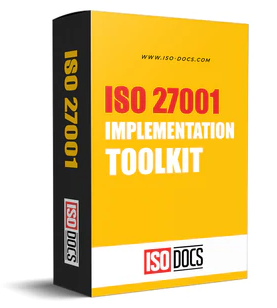Analyze the Internal and External Environment Under ISO/IEC 27001:2022
Introduction
This involves context analysis and the understanding of the internal and external environment, which form an essential requirement under ISO/IEC 27001:2022, in order to build a successful Information Security Management System (ISMS) that withstands today's threats. This is emphasized in the 2022 update of this internationally recognized standard, which encourages organizations to adopt a structured and context-driven approach in confronting information security issues, establishing a much stronger basis for understanding risks than identification alone. Here we discuss how to systematically analyze internal and external environments in accordance with ISO/IEC 27001:2022, ensuring your ISMS is going to be both good practice and compatible with real-world dynamics in your organization and beyond.

What Is The Importance Of Context In ISO/IEC 27001:2022?
Clause 4.1 of ISO/IEC 27001:2022 mandates organizations to establish both internal and external issues that can have an impact on the intended outcomes of the ISMS. To understand this context is no longer a checkbox exercise; it is a very strategic activity that is going to inform the ISMS scope, objectives, and control framework, consequently driving stakeholder trust in your security program.
What Is Environmental Analysis In ISO/IEC 27001:2022?
Environmental analysis-in the meaning of ISO/IEC 27001:2022-means to identify and assess the internal and external factors, positive or negative, affecting the achievement of information security objectives. This would further identify risks and sharpen the process of identifying them to assist organizations in fine-tuning controls and their policies for maximum effectiveness.
1. Internal Environment Analysis
Internal problems constitute those that can straightforwardly influence the organization itself. They can be analyzed against this backdrop by the model for IPOPS as effectively informed by ISO/IEC 27001 guidance. IPOPS consists of the following: Information as Assets, People, Organization, Products & Services, and Systems & Processes:
-
Information Assets: What must the organization generate, store, or process as sensitive data (for example, personal data, IP, or financial assets)? Therefore, it is very much a prerequisite for risk management to ensure proper inventory and classification.
-
People: Recruitment, training, retention, staff turnover, or cultural attitudes toward security are human resources challenges that significantly impact how well security policies are adopted.
-
Organization: Structure, leadership styles, geographic dispersion, and growth rate all affect ISMS implementation. Fast-growing or decentralized organizations face extra hurdles in maintaining consistent policy enforcement.
-
Products & Services: Security dependencies shift with the offering. Manufacturers may focus on physical security, while SaaS firms emphasize digital controls and uptime.
-
Systems & Processes: Check both manual and automated workflows because old standard processes or undocumented practices can hide weaknesses.
2. External Environment Analysis
Take external issues that are not directly controllable by the organization; however, they must be recognized so that ISMS can be adapted adequately. PESTLE (Political, Economic, Sociological, Technological, Legal, Environmental) is commonly used to rate such issues.
-
Political: Changes in security requirements may be invoked by laws-regulations (e.g., GDPR), policy changes, and political stability.
-
Economic: With market fluctuations and supply chain disruptions coupled with cost-related pressures, resource availability for security investments is put on an uncertainty basis.
-
Sociological: Changing demographics of workers, customer expectations, and cultural attitudes may introduce new security threats.
-
Technological: New technologies such as Artificial Intelligence, cloud computing, or IoT will lead to newer opportunities and vulnerabilities that will need to be addressed with newer controls.
-
Legal: There is a need to comply with the development of legislation around privacy, data security, and industry-specific rules.
-
Environmental: Growing considerations for sustainability could lead to alterations in asset management (for example, less paper, remote working).
What Are The Practical Steps For Implementation?
-
Involve risk management and compliance officers and technical staff in PESTLE workshops to identify relevant trends.
-
Track current changes so that the ISMS can be maintained vis-a-vis new legal or technology changes.
-
Map relationships with suppliers, partners, and all other external stakeholders, as third-party risks are a key source of incidents.
What Does Linking Analysis To The ISMS Lifecycle Involve?
Effective analysis of internal and external environment shapes every stage of the ISMS lifecycle:
-
Scope Definition: Contextual determination accurately captures the boundaries of the ISMS, thus avoiding gaps.
-
Risk Assessment and Treatment: Knowledge with context enhances the identification of threats and strengthens mitigation strategy.
-
Management Review: Assessing external and internal issues is a requirement of Clause 9.3, enabling continuous improvement and adaptive changes with the environment.
-
Audit and Documentation: ISO/IEC 27001:2022 does not require context to be documented separately, but evidence of environmental analysis is an auditor requirement.
Conclusion
The idea is certainly based on a much-detailed, systemic analysis of all environments, internal and external-from the ISMS scope to risk treatment and continuous improvement, which is indispensable for compliance with ISO/IEC 27001:2022. Organizations should not view environmental analysis as a single requirement; it is going to have to be repeated, then, to bolster the resilience of the organization against changing digital threats and regulatory expectations. For, incorporating it into your ISMS sets an overarching groundwork for security, regulatory fitness, and trust.
FAQs
1. What does analyzing the internal and external environment mean in ISO 27001:2022?
It means identifying all internal and external factors that influence your ISMS—such as business processes, culture, market conditions, legal requirements, and stakeholder expectations.
2. Why is environment analysis important for ISO 27001 compliance?
It helps organizations understand risks, plan controls effectively, and ensure the ISMS aligns with business objectives and real-world conditions.
3. What internal factors should an organization analyze?
Internal processes, technologies, organizational structure, policies, human resources, capabilities, culture, and existing security practices.
4. What external factors must be considered in ISO 27001:2022?
Legal and regulatory requirements, market trends, industry threats, competitors, supply chain, geopolitical issues, and technological changes.
5. Which clause covers internal and external environment analysis?
ISO/IEC 27001:2022 Clause 4.1 – Understanding the Organization and Its Context.
6. How often should internal/external environment analysis be updated?
At least annually, and whenever major business, regulatory, or technological changes occur.


